中国人民大学 2010 年考博英语真题
Part I Vocabulary (20%)
Directions: Choose the best answer {from A, B, C and D) to complete each of the
following sentences. Mark your choice with a single bar across the square brackets
on your Machine -scoring ANSWER SHEET.
1. Today scientists have a greater understanding of genetics and its role in
organisms.
A. live B. life C. living D. alive
2. The news commentator says that the argument the speaker has presented does not
water.
A. have B. contain C. include D. hold
3. Terrorists murder and kidnap people,
commit other serious crimes.
bombs, hijack airplanes, set fires, and
A. light up B. set off C. plant in D. ignite
4. Television has become quite a vigorous activity. Sitting up is exhausting so
most people down while watching television.
A. lay B. lie C. lying D. lied
5. If each of us does our part little by little, we can
and ourselves.
the lifespan of our planet
A. enlarge B. expand C. increase D. grow
6. The role of American women significantly from the time the nation was born, to
the modern era of the 1950s and 1960s.
A. has changed B. has been changed C. changed D. had been changed
7. Financial statement is a financial report or record usually on a quarterly and
annually basis which provides an individual’s,an organization’s,or bussiness’
s financial states.
A. competed B. compiled C. collated D. contested
�
8. Management operates through various , often classified as planning, organ
leading/ motivating and controlling.
A. foundations B. functions C. roles D. relations
9. The Jatakana culture encompasses every
and practices to art, education and tourism.
of life from beliefs, superstitions,
A. respect B. inspect C. aspect D. suspect
10. Organizational culture can be defined as a system of shared beliefs and values
that develops within an organization and behaviors of its members.
A. guides B. indicates C. controls D. supervises
11. Everyone in America these days seems to be with his or her physical fitness,
and everyone is talking about getting in shape.
A. concerned B. allured C. connected D. attracted
12. The Internet has been around for an almost equal amount of time as most forms
of media, but only recently a popular way of retrieving information.
A. has it become B. it has became C. it becomes D. does it become
13. Censorship,a word that seems to be quite controversy over certain people, may
not be such a bad idea.
A. arguing B. attacking C. causing D. discussing
14. We are living in the midst of a great chemical experiment and some consequences
are becoming apparent to scientists.
A. cereal B. serial C. series D. serious
15. For the last 20 years or so the subject of global warming has heated debate
among the world’s brightest minds.
A. spawned B. injected C. modeled D. moved
16. In today’s modern society alcohol addiction and alcohol has become one of the
most complex life-threatening issues.
�
A. infuse B. abuse C. reduce D. refuse
17. He argued that the of firearms in America is an illegal act, and degrades the
values this country was founded on.
A. banning B. prohibit C. vote D. forbid
18. Advocates of private school argue that education in one of these facilities
is more valuable and than any other educational opportunity.
A. awarded B. awarding C. rewarded D. rewarding
19. Children are often sports at an early age. As they get older and start school
they participate in sports as a way both to make new friends and be active.
A. exposed to B. spoiled by C. indulged in D. worried about
20. Although the study of genetics is an entirely new field, it mankind for many
years.
A. has combined B. has interested in C. has involved D. has fascinated
Part II Reading Comprehension (30%)
Directions: Choose the best answer {from A, B,C and D) to complete each of the
following sentences. Mark your choice with a single bar across the square brackets
on your Machine-scoring ANSWER SHEET.
Passage One
In 1987,H. I. V/AIDS joined a list of diseases that could keep a person out of
the United States. The government later tried to cancel, its decision,but congress
made the travel ban a part of immigration law. People with H. I. V.,the virus that
causes AIDS, could seek an exception, but that meant extra work. Last year, Congress
and President George W. Bush began the process of ending the travel ban. Now
President Obama is finishing the process.
BARACK OBAMA : “We talk about reducing the stigma of this disease, yet we have
treated a visitor living with it as a threat. We lead the world when it comes to
helping the AIDS pandemic, yet we are only a dozen countries that still bar people
H. I. V. from entering our country. ” A final rule published Monday will end the
travel ban effective January fourth. H. I. V. will no longer be a condition that
can exclude people. And H. I. V. testing will no longer for those who need a medical
examination for immigration purposes. AIDS has killed more than twenty-five people
�
since the early 1980s.
In September, there was news that a vaccine showed some ability to prevent H. I.
V. infection in humans for the first time. The full results of the vaccine study
were presented in later October at an international conference in Paris. They were
also reported in the New England Journal of Medicine. The researchers confirmed
that the study in Thailand produced only “modest” results. The United States Army
sponsored the vaccine trial. The study combined two vaccines, using versions of
H. I. V. common in Thailand. Neither vaccine alone had shown success in earlier
studies. Thai researchers tested the combination in more than 16, 000 volunteers.
Half of the volunteers got the vaccine. The others got a placebo, an inactive
substance. All were given condoms and counseling on AIDS prevention for three years.
The study found 31 percent fewer cases of infection in the vaccine group than in
the placebo group.
But critics said the findings could possibly have resulted from chance. The
announcement in September was based on all 16, 000 volunteers. Almost one-third
of them, however didn’t follow all the required steps in the study. Results just
from those who did were similar to the larger group, but the influence of chance
is way more of a possibility. Still, the researchers said the study produced enough
valuable information to offer new hopes for AIDS research.
21. According to the article,
to America twenty years ago.
did not want people with H. I. V. virus to seek entry
A. George Bush B. Obama C. the Congress D. the Senate
22. According to this article, it was
find vaccine for H. I. V. carriers.
who sponsored that medical experiment to
A. the Thai Government B. the French Government
C. the scientist from New England D. the United States Army
23. From the article we can infer that 8,000 volunteers in were given the vaccine.
A. Thailand B. the United States of America
C. France D. Canada
24. According to the article, which one of the following statements is true?
A. America was the only country that prevented people with H. I. V. from entering
the country.
�
B. Only a few countries refused to issue entry visa to people with H. I. V.
C. The conference held in Paris was on AIDS prevention.
D. The vaccine test conducted in Thailand produced important results.
25. According to the critics, the findings of the test .
A. has produced enough valuable information
B. should not be taken seriously
C. has produced reliable statistics
D. has paved a solid foundation for further research
Passage Two
“ Two hundred eight million, two hundred nine million, two hundred ten million...”
That is the sound of solid waste hitting the bottom of garbage cans all over United
States in 1996. Solid wastes are materials that are discarded or thrown away after
use by consumers and businesses. This does not include fluid materials. During that
year, Americans threw away 210 million tons ( about 43 pounds/20 kilograms per person
daily) of garbage. We throw away 12. 4 million tons of glass and about 80 million
tons of paper products. America also throws away large amounts (in tons) of food
scraps, yard wastes, plastics, sludge from sewage treatment plants, and other
materials. That is almost a mountain of garbage.
Even though we make an effort to recycle and compost our solid waste, the amount
of waste keeps increasing each year. Our biggest problem is where to put the solid
waste and how to keep it from polluting our environment. If solid waste is disposed
of incorrectly, it can contaminate our surface and underground water supplies.
Currently, our municipal waste or waste collected by our cities and towns, goes
to landfills. Today, about 85% of our garbage goes to landfills or garbage dumps.
This waste must be treated to keep rats, flies and other animals from building their
home in the landfills. The treat also prevents the growth of bacteria and other
organism that carry diseases. So, how do we handle this
mountain of garbage? Scientists have come up with different methods for handling
our waste problem.
One type of waste disposal called sanitary landfill was first used in Fresno
California, in 1937. In sanitary landfill, the solid waste is spread in thin layers
�
that compacted and covered with a layer of earth. This is a more expensive method,
but it takes away the hazards that are caused by landfills. It also allowed the
land to be used for building or recreation. The negative of the landfills is that
it’s tough to find open land and this process is very expensive. The land also
needs its water sources protected so that the water will not pollute the water supply.
Landfill (water dumps) and sanitary landfills rely on the natural biodegradability
of the solid wastes. Solid wastes are biodegradable if they can decay or break down
through the action of living organisms and return to the earth. However certain
materials take longer to decay than others, and some materials do not decay or
decompose at all. Scientists need to find other methods of waste disposal.
Incineration and recycling are methods that are currently in use today.
26. This passage is about disposal problem of solid waste .
A. by consumers B. in California
C. by municipal government D. in America
27. From the article we can infer that .
A. treatment of the solid is a hard nut to crack
B. solution for proper disposal will be found soon
C. California set a good example in solid waste in 1930s
D. the government remains confident about the solid waste
28. According to the article, about is dumped to landfills.
A. 12. 4 million tons of garbage B. 80 million tons of garbage
C. 85% of the garbage D. 92. 4 tons of garbage
29. The word “recycle”( Line 1, Paragraph 2) means .
A. to send something far away B. to throw something away to the right place
C. to convert waste into reusable material D. to turn into fertilizers
30. According to the article, which one of the following is NOT true?
A. Solid waste does not include fluid materials.
�
B. Sanitary landfill is a type of waste disposal method once used in California.
C. Burning is not a method that is used today.
D. Composting is still one of the ways to handle the mountain of garbage.
Passage Three
Who would have thought we would become a planet of “ologies”? There’s biology,
psychology, herpetology, etymology, and geology just to name a few. However, one
“ology” truly helps us to understand the most part of our planet, our environment.
Ecology (which is filled with ecologists) is the study of ecosystems and the beings
and organisms that inhabit those ecosystems. Just think, in condition of bees, deer
and other organisms, you are important to ecologists. Ecosystems are communities
that vary in size and location. They can be as small as a patch of glass or as large
as the entire biosphere. The many varieties of plants and animals that exist in
our planet ecosystems are important to our ecosystems. Plants in particular provide
oxygen and nutrients all organisms need to survive. These producers have the ability
to use the sun’s energy to produce food
(think photosynthesis). This is where the animals and consumers become important.
The animals get their energy by eating the plants and other organisms within the
ecosystem. Without the producers and consumers, decomposers would not have a job.
As you may have guests, decomposers, like bacteria, step in broken down, the organic
materials are absorbed by the soil and gases are sent back into our atmosphere.
The whole process is ready to start again through the Earth’s natural cycles. There
has to be a balance of producers, consumers, decomposers in order to remain a
balanced ecosystem.
Remember, all organisms need matter and energy to survive. An ecosystem is balanced
when matter and energy move efficiently through those ecosystems. Just as your
backpack has a limit on the number of huge textbooks it can carry at any given time,
all ecosystems have a limit on the populations they can maintain. Carrying capacity
is the largest population an ecosystem can support at any particular time. The
support of this population depends on the amount of resources (matter and energy)
that are available and the movement of those resources within that ecosystem. If
energy and matter are moving efficiently through an ecosystem, then the current
population of plants and animals has not reached beyond the ecosystem ’ s the
ecosystem ’ s carrying capacity. Once resources dwindle or animal populations
increase dramatically, the ecosystem may not be able to support those populations.
Fortunately, nature has three ways to control the balance of ecosystems: ecological
responses to change, energy transfer, and food chains and food webs.
31. The purpose of starting the article with the word-ending “ology” ( Line 1,
�
Paragraph 1) is
A. to trace the origin of “ology”
B. to give an example for the meaning of “ology”
C. to introduce the term “ecology”
D. to illustrate the importance of balancing the ecosystems
32. According to this article, the ecosystems .
A. are in danger of being destroyed B. are very small in size
C. refer only to the entire biosphere D. vary greatly in size and location
33. According to the article, the word “producers”(Line 4,Paragraph 2) refers
to •
A. plants B. animals C. ecologists D. consumers
34. We can infer from the article that in the ecosystem the job for the “decomposer”
( Lines 7-8, Paragraph 2) is to •
A. absorb the sun’s energy
B. produce oxygen and nutrients
C. break down the dung and the remains of dead organ
D. eat the plants and animals
35. According to the article,
ecosystems.
has three ways to control the balance of the
A. human beings B. the environment C. animals and plants D. nature
Passage Four
In modem days, on the western bank of the upper Tigris River stands an Iraqi city
called QaFat Shartlat. Thousands of years ago, this very site was once the capital
of a great Mesopotamian empire. At the time, the place had a different name. It
was called Ashur or Arrur. The word Ashur eventually gave rise to the team Assyria,
which was the northern part of Mesopotamia. People living in that region later became
�

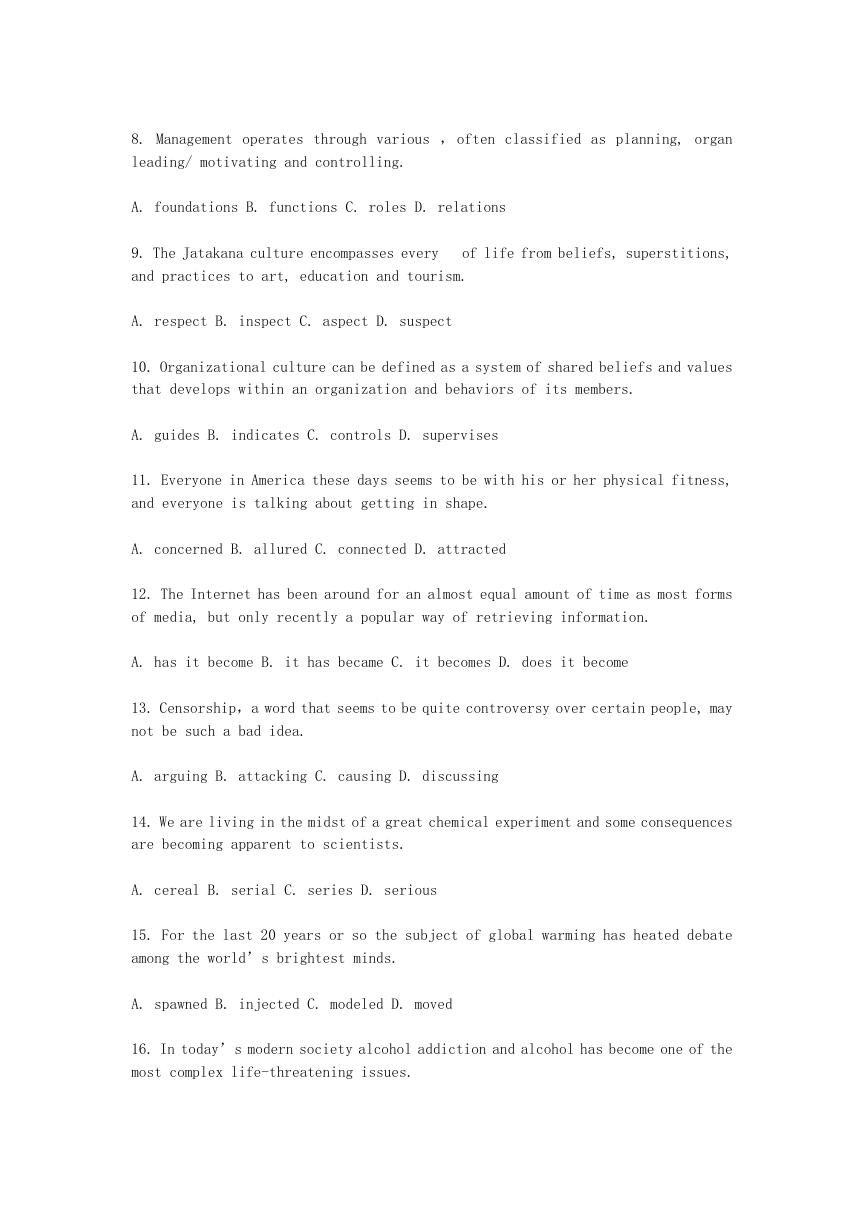

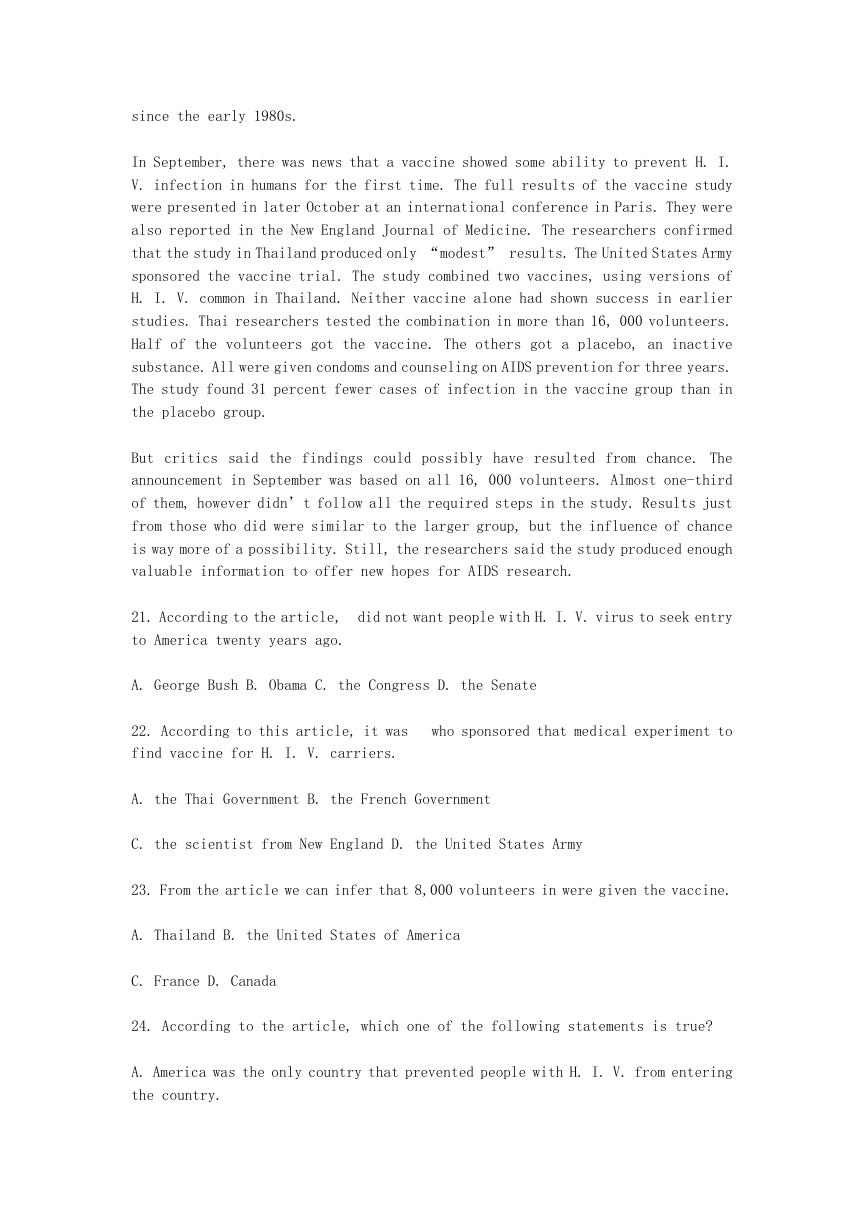
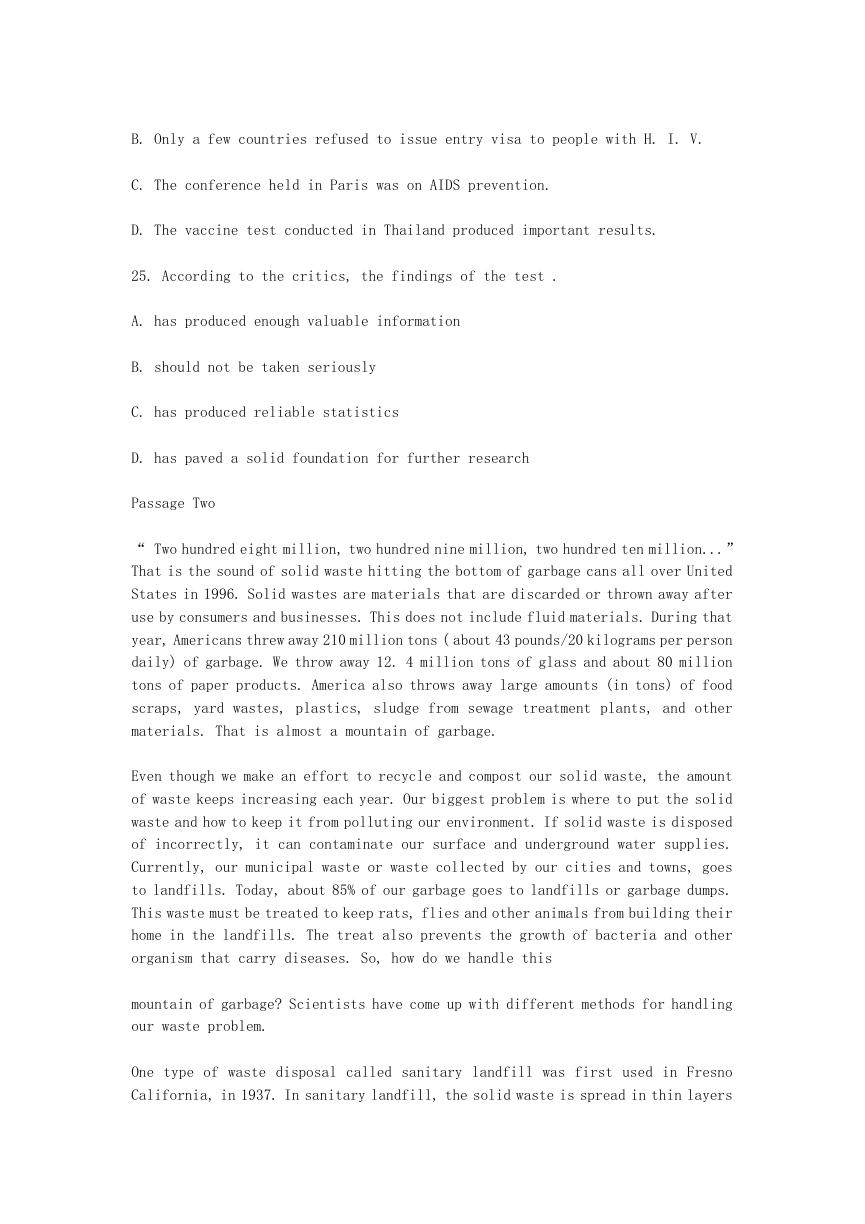

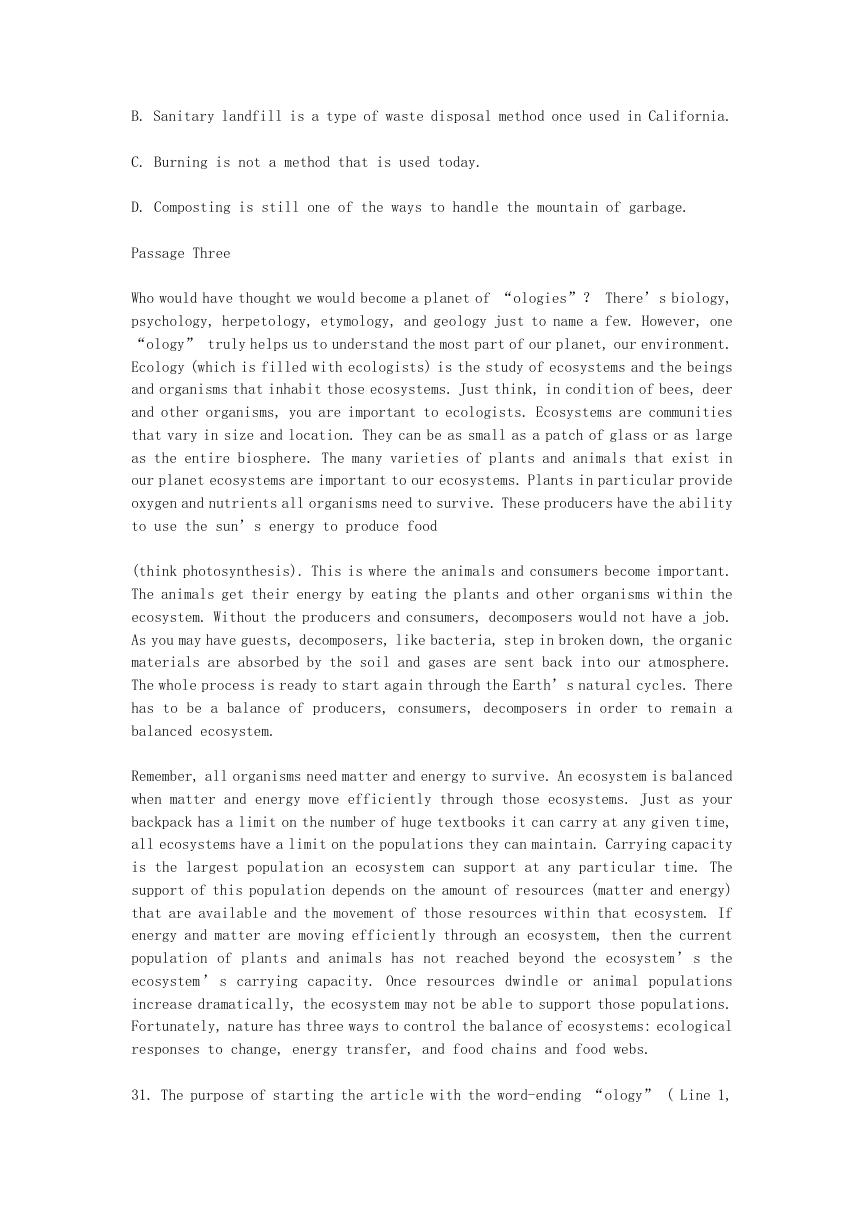
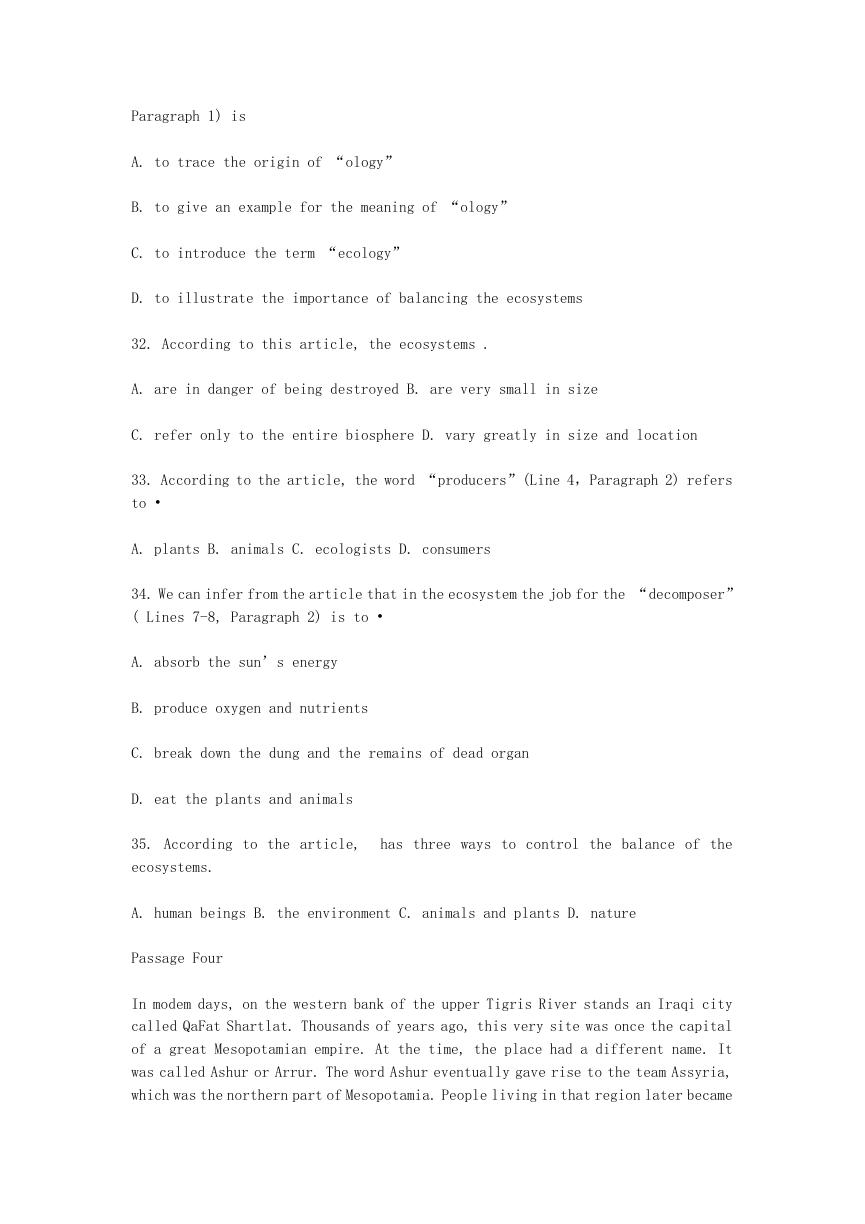








 2023年江西萍乡中考道德与法治真题及答案.doc
2023年江西萍乡中考道德与法治真题及答案.doc 2012年重庆南川中考生物真题及答案.doc
2012年重庆南川中考生物真题及答案.doc 2013年江西师范大学地理学综合及文艺理论基础考研真题.doc
2013年江西师范大学地理学综合及文艺理论基础考研真题.doc 2020年四川甘孜小升初语文真题及答案I卷.doc
2020年四川甘孜小升初语文真题及答案I卷.doc 2020年注册岩土工程师专业基础考试真题及答案.doc
2020年注册岩土工程师专业基础考试真题及答案.doc 2023-2024学年福建省厦门市九年级上学期数学月考试题及答案.doc
2023-2024学年福建省厦门市九年级上学期数学月考试题及答案.doc 2021-2022学年辽宁省沈阳市大东区九年级上学期语文期末试题及答案.doc
2021-2022学年辽宁省沈阳市大东区九年级上学期语文期末试题及答案.doc 2022-2023学年北京东城区初三第一学期物理期末试卷及答案.doc
2022-2023学年北京东城区初三第一学期物理期末试卷及答案.doc 2018上半年江西教师资格初中地理学科知识与教学能力真题及答案.doc
2018上半年江西教师资格初中地理学科知识与教学能力真题及答案.doc 2012年河北国家公务员申论考试真题及答案-省级.doc
2012年河北国家公务员申论考试真题及答案-省级.doc 2020-2021学年江苏省扬州市江都区邵樊片九年级上学期数学第一次质量检测试题及答案.doc
2020-2021学年江苏省扬州市江都区邵樊片九年级上学期数学第一次质量检测试题及答案.doc 2022下半年黑龙江教师资格证中学综合素质真题及答案.doc
2022下半年黑龙江教师资格证中学综合素质真题及答案.doc